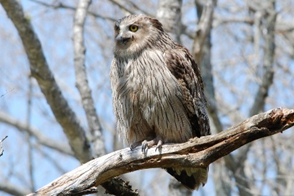Press ReleasesMemorandum Concluded with Wild Bird Society of Japan on Conserving a Habitat for Blakiston's Fish Owl- Coexistence of biodiversity conservation and the logging operation through cooperation-
Nippon Paper Industries Co., Ltd.
Nippon Paper Industries Co., Ltd. (President: Fumio Manoshiro; hereinafter, "Nippon Paper Industries" or "the Company") and the Wild Bird Society of Japan (Chairman: Hiroshi Yagyu), a public interest incorporated foundation, concluded a memorandum that sets the standards for the coexistence of conserving a habitat for Blakiston's fish owl (Note 2), which is designated as a protected species in Japan and is also an endangered species, and the logging operation in a forest (around 1,986 hectares, Note 1) that the Company owns in the Kushiro region of Hokkaido.

Blakiston's fish owl is one of the animals that sits atop the ecological food chain, and the forests they inhabit are said to be critical in conserving a natural environment brimming with biodiversity. Nippon Paper Industries and the Wild Bird Society of Japan have been working on wild bird conservation aimed at protecting Blakiston's fish owl since we entered into an agreement to jointly establish the Nippon Paper Industries No. 3 Nemuro Wild Bird Sanctuary for Blakiston's Fish Owl in October 2010 for a forest (around 126 hectares, Note 1) that the Company owns in the Nemuro region of Hokkaido. In this process, the parties fostered a sense of mutual understanding and trust, which led to our entering a new memorandum this time around.
The subject forest in this memorandum is one that the Company has owned for many years for the purpose of logging operation. The Company received the SGEC forest certification (Note 3) in 2005 as a result of its practical work on conserving a rich natural environment while providing due attention to biodiversity. The memorandum that was concluded this time around stipulates in specific standards to consider in the Company's logging operation conducted near the owl's nesting trees. This took place after we jointly conducted a study on the home range of Blakiston's fish owl following confirmation that they were breeding on the site where tree thinning took place in 2011. The content is a further progression of the Company's forestry management to date, which has aimed at the coexistence of biodiversity conservation and logging operation.
Going forward the Company will work on further enhancing a sustainable forest management that leads to conserving the Blakiston's fish owl while referring to the knowledge provided by the Wild Bird Society of Japan.
- Note1:The location, regional name and other detailed information of the forests in the agreement as well as the memorandum has not been disclosed from the perspective of conserving Blakiston's fish owls.
- Note2:The range of distribution of the Blakiston's fish owl is a limited area in the Far East region and the owls inhabit the central eastern portion of Hokkaido in Japan. Its height measures 70 to 80 centimeters and the wingspan is around 180 centimeters, making it the largest owl in the world. It used to be widely distributed in all of Hokkaido, but at the moment, only around 50 pairs and 140 owls are alive, with the owls designated as critically endangered species on the Ministry of the Environment's Red List. It was also designated as a protected species in Japan in 1971 and a national endangered species in 1993.
- Note3:A forest certification system is tailored to the characteristics of forests in Japan, which was established in 2003. (http://www.sgec-eco.org/index.html)
-
-